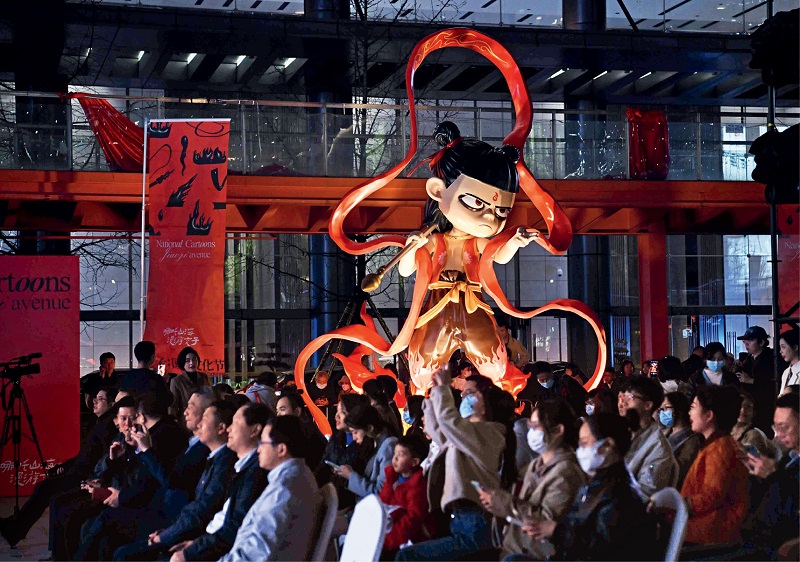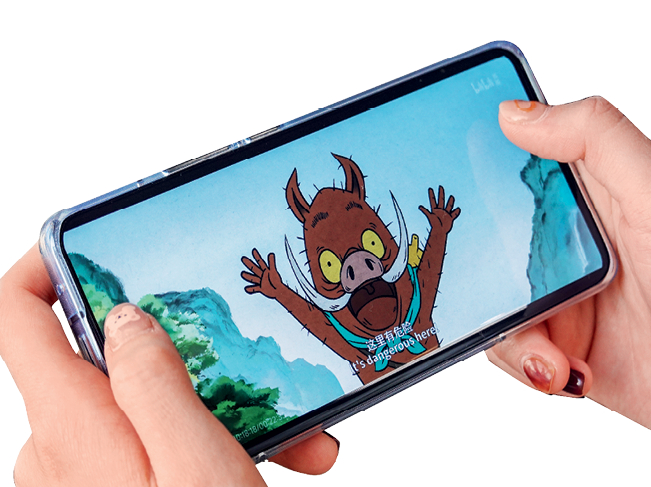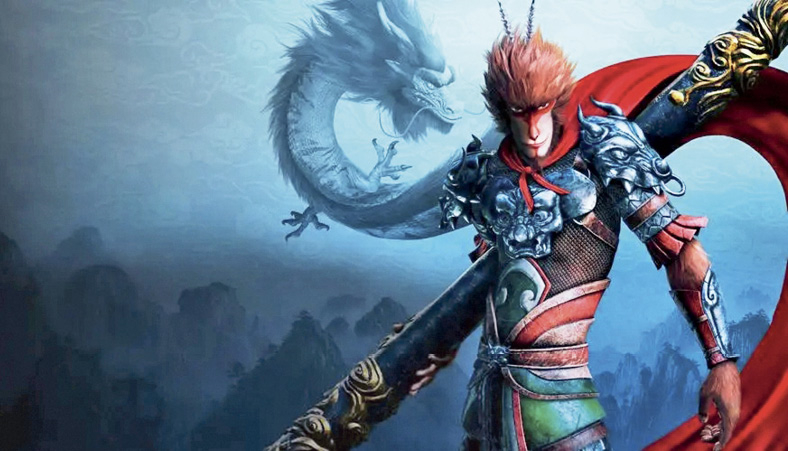Pioneering Shanghai studio boosts Chinese animation with new series Yao-Chinese Folktales, combining distinctive Chinese aesthetics with details from real life.

The six-meter-high “Ne Zha” IP sculpture is completed in the Jiaozi Avenue Music Plaza during the 2023 Jiaozi National Cartoons Festival held in Chengdu, Sichuan Province on March 17, 2023.
Love, Death + Robots, move over. The five-time Emmy-winning animation series by American filmmakers Tim Miller and David Fincher has stiff competition in China – from a new series that has captured the hearts of viewers with its presentation of a fabulous world where fertile imagination couples with unique Chinese aesthetics. Zhongguo Qitan or Yao-Chinese Folktales, which premiered on the video streaming platform Bilibili on January 1, has since been trending across several major social media platforms, with over 260 million views and a 9.6 rating on rating platform Douban.
Sowing the Seeds
The idea of making Yao-Chinese Folktales, a collection of eight stories themed on monsters whose acts however are a reflection of human society, took root in the year 2022, a significant year for Chinese animation, marking the centenary of the industry. Shanghai Animation Film Studio, a pioneer established in the 1950s, planned to celebrate the centenary with an animated show. So did Chen Liaoyu, associate professor at the Animation School of Beijing Film Academy, and the two came together to produce Yao-Chinese Folktales.
The series is inspired by a 1980s animated film based on the supernatural and mythical, the Legend of Sealed Books, also produced by Shanghai Animation Film Studio. One of its directors, Qian Yunda, was Chen’s university professor. One character in Yao-Chinese Folktales originates from the Legend of Sealed Books.
While Chen is the chief director, a team of younger artists working with him to make the series were urged by him to leave their comfort zones and explore new things.

Yao-Chinese Folktales receives high marks from netizens.
Unique Feature
The most distinctive feature of Yao-Chinese Folktales is its Chinese style. Visually, it integrates Chinese art forms like paper cutting and ink painting. Its plots borrow from traditional Chinese folktales, and the eight short stories explore topics as diverse as changes in China’s rural areas and space technology.
The success of the series is due to its vivid reflection of real human life. Nobody, the first episode, is the story of a pig monster based on the classic Chinese novel Journey to the West, but viewers see shades of human dictators in the monster’s leader who assigns unreasonable tasks and changes them constantly. At the same time, there is something of every man in him. When he says, “I want to leave Langlang Mountain,” it’s an echo of migrants leaving their hometowns to earn a better living in the big cities.
The protagonist in the seventh episode Old Man Yang, who speaks with a Beijing accent, is not used to paying water bills by phone and doesn’t want to throw away old stuff. The audience associates him with elderly family members struggling to come to terms with changes in time and technology. Such resonances generate great empathy.
However, Yao-Chinese Folktales has not received just bouquets. After all eight episodes were released, its rating fell to 8.8 on Douban. There was much criticism about the sixth episode Null Island, suggesting the storyline was far from outstanding.
Chen’s response is that Yao-Chinese Folktales is exploring new things with the readiness to take risks: “We don’t want to apply one single storytelling or artistic style … even if we are certain it will receive positive feedback. If we do so, we are not innovating. We want to … provide diverse stories with abundant possibilities.”
In Chen’s view, what genuinely delights creators is not compliments from the viewers but their different interpretations of the work. Netizens discuss the plots and scenes of Yao-Chinese Folktales and even re-create them. Such interpretations help other viewers understand obscure parts and expand the influence of the animation.

The post of the Chinese animated film Monkey King: Hero Is Back.
 Rise, Fall & Rejuvenation
Rise, Fall & RejuvenationChinese animation is considered to have begun with an animated advertisement for a typewriter in 1922. Then Shanghai Animation Film Studio was established in 1957, playing an essential role in China’s animation history. It has produced many classic animations, influencing generations of viewers.
But when China started reform and opening-up in 1978, animation from countries like Japan and the U.S. was introduced into the mainland and began to steal the show on China’s animation market. Young people were attracted by foreign animation such as Astro Boy, Doraemon, and Pokémon for their excellent storytelling and high quality. By contrast, there weren’t many impressive Chinese animation at that time.
But in the 21st century, under the government’s support, many Chinese animation knockouts started to emerge. They were based on traditional Chinese culture and were well received by audiences, marking the rise of Chinese animation once again. Chen says today Chinese animation has entered a stage of awakened self-awareness, exploring the country’s unique styles and growing more mature.
However, there are still many problems beleaguering Chinese animation. One is the lack of diversity. Most animation hits in recent years are related to traditional Chinese folktales. For example, White Snake: The Origin has its roots in the Legend of the White Snake. Such works stem from the cultural resources of China’s long history but do not touch upon modern Chinese life. Another problem is a lack of sophistication. Recent box-office hits like Pleasant Goat and Big Big Wolf target children as their audience and due to its lack depth in storytelling, it fails to appeal to adults. Besides, lack of creativity and cliched plots have also limited the development of Chinese animation, and filmmakers need to improve their efforts to meet the market demands.
In the meantime, the second season of Yao-Chinese Folktales is in the works. While it remains to be seen whether the second season can outperform the first, Chinese animation needs more such explorations to consolidate its rise.